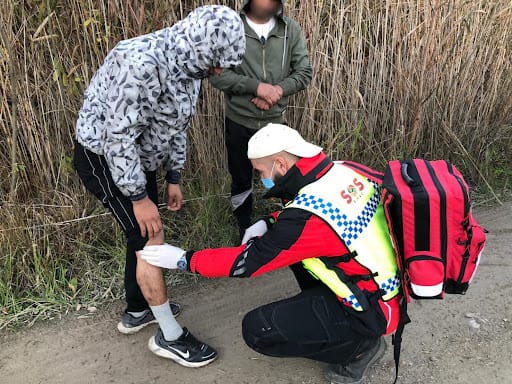- Distribute Aid
- Posts
- When you’re bleeding, you need a bandaid
When you’re bleeding, you need a bandaid
On the aid world’s most contentious debate
Hi, you might be wondering why you received this email! We’ll keep it quick: Distribute Aid is starting a monthly newsletter, and we decided to send this first edition to everyone who’s donated or volunteered with us in the past.
Each month we’ll give an insider’s look into the world of humanitarian aid. You can expect short, thoughtful analysis of the missions, debates, and controversies that have captured (or deserve more of) people’s attention. We hope you’ll enjoy these little glimpses behind the curtain of nonprofit disaster relief—and if not, there’s an “unsubscribe” button at the bottom of this email!
- Sara Lonegard & the Distribute Aid team

An aid worker applies a bandage to the leg of an injured refugee.
Recently, I was invited to speak at a fireside chat with several other mutual aid groups. At one point the conversation turned to Distribute Aid’s Harm Reduction Toolkit campaign, which is currently raising money to provide DIY hormone therapy kits for trans people in US states where gender-affirming healthcare is threatened by the Trump Administration.
“That’s nice,” someone said, “but wouldn’t it be better if the people you’re helping could get professional care from a doctor, instead of having to do it themselves?”
I couldn’t have agreed more—or been more frustrated by the question.
Humanitarian aid work is often compared to bandaids. The analogy is accurate in many cases. A big structural problem—like a lack of healthcare, or babies going hungry—flares up, and organizations like ours arrive with toolkits and baby formula. The immediate need is addressed, while the root causes of the problem remain.
Here’s the thing about bandaids, though: they’re part of a first aid kit. That kit equips a medic who prevents someone from bleeding out. The bandaid is meant to be just one part of a holistic response.
Much of what we do at Distribute Aid is focused on this “deeper” work. We create networks of manufacturers and care providers, and the supply chains to connect them. We train people with the technical skills to master international logistics. We equip communities with the open-source tools to meet their own disaster relief needs, whatever those might be, as much as humanly possible.
But the bandaid work is the most easily photographed, and often the easiest to quantify. People can see the trucks full of T-shirts; they can count how many are in each box. And if they’re clever, they’ll think, “Wouldn’t it be healthier for the community if people could get their clothes from a small business owned by one of their neighbors?”
Of course! Even the most responsible humanitarian aid, delivered with the best of intentions, is no substitute for a self-sustaining economic ecosystem and a robust social safety net.
For many problems, it’s not a sufficient solution—but it is often a necessary one.
“Bandaids help people get through the worst moments of their lives, and reach a point of being able to support themselves,” I replied to my peer who asked the question. “Just like how aid responses get communities through a crisis, leaving them more resilient for the next one.”
Personally, I’m thrilled that more and more aid workers are recognizing that we need structural solutions to structural problems. Meanwhile, so many people are still bleeding. That’s why we’ll keep sending them bandaids—at the same time as we work to heal the deeper wounds.
Quick hits:
ICYMI: our HRT toolkit project was featured in this article from PRISM about how trans people are preparing for the Trump years.
Vu Le’s blog NonprofitAF is always worth reading—especially if you roll your eyes at typical nonprofitspeak—but his latest piece on everyday actions to keep the world kind, just, and joyful is especially timely.
Cutbacks in U.S. foreign aid put life-saving projects all around the world in jeopardy, and another $2 billion that was supposed to be released has been frozen by the Supreme Court.
Thoughts from a frontline partner: Anera shows how the latest Gaza aid freeze is part of an ongoing cycle of instability that needs to be stopped.